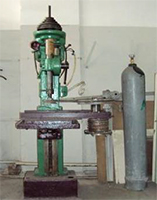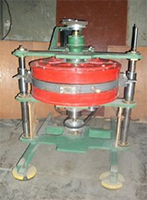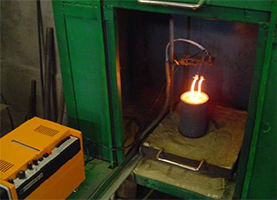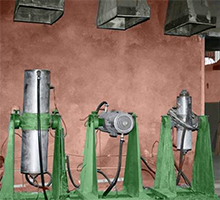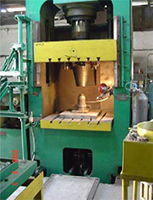At present, the priorities of the Institute are: rational use of natural resources, obtaining & processing of new inorganic materials, and the development of environmentally sound technologies, utilizing & recycling of industrial wastes.
Accordingly, the main directions for the Institute are inorganic materials science and metallurgy. The Institute also conducts expert works in samefields.
|
|
|
| Attritory-type high-energy grinding mill | Magnetic jet grinding mill of material dispersion |
Commercial interest in the technology developed at the Institute is determined by:
- an effective combination of properties of abrasiveness, heat resistance, corrosion- and wearresistivity of ceramics with the ductility and impact toughness of metals in metal-ceramic compositions. Parameters of the obtained compact products are:

- manufacture of goods of a new generation, significantly better than existing products: cutters, peepholes, valves for pipelines, nozzles of water-blast-cutters, shafts for high-pressure compressors, and others;
- the relative simplicity of the technology cycle, providing non-waste technologies and solutions to environmental problems, reducing the energy consumption by 30–40%;
- hardening and restoration & update the surfaces of machine parts of special or consumer purposes used in machine-engineering, aviation and steel mills, oil refineries and mining-processing enterprises and jewelry and other objects of individual labor with the help of electro-spark alloying, gas and plasma arc-coatings using the sintered electrodes made from the produced in the Institute powders and powder-cored electrodes as well.
The technology of self-propagating high-temperature synthesis
In this direction, the results obtained in our Institute are truly evident and they are considered along with the results of the world’s leading scientific schools working in same field.
The Institute began with a broad front research in the field of self-propagating high-temperature synthesis. In a short time, it has been synthesized essentially novel hard alloys, metallic and hightemperature ceramic superconductor materials, boron carbide, boron nitride, and others.
This direction has been devoted by the joint monograph by Giorgi Tavadze from the Institute and his US colleague Alexander Shteinberg “Production of Advanced Materials by Methods of Self- Propagating High-Temperature Synthesis”, which was published by the Springer.
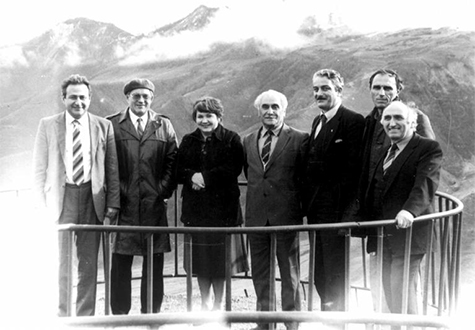
Academicians: Alexander Merzhanov, Nikolay Vatolin, Ferdinand Tavadze, professors: Inna Borovynskaya, Tengiz Sigua, Jumber Khantadze and Guri Tsagareishvili at the Jvari passage
It should be noted technology for the production of composite armor and structural ceramic materials. Ceramic composite materials of complex phase composition were obtained during the joint synthesis of boron carbide, corundum, boride, titanium diboride, and other compounds. They are distinguished by high plastic properties, resistance to cracking, hardness, good manufacturability and low costs. In its ballistic stability, the ceramic armor material “Tori” surpasses well-known armor material – boron carbide, and in manufacturability and cost-efficiency – corundum.
Significant results were also observed in the study of multi-functional metalceramic materials. The carbides-nitrides-borides-based materials with unique properties were obtained by the energy-saving and environmentally friendly method of self-propagating high-temperature synthesis. Theirs high hardness, abrasion-resistance and compressive strength together with a rather high impact toughness allow the production of metal-ceramic gradient materials for civil and defense purposes as well. It also should be noted that works towards obtaining functional- gradient composite materials are conducted in the United States, Japan and Georgia – in the Ferdinand Tavadze Institute of Metallurgy and Materials Science.
|
|
|
|
|
| a | b | c | d |
Installations for the SVS: in atmospheric conditions (a), in a centrifugal force field (b), in the high-pressure reactor (c) and at compression (d).
In a thermal explosion regime developed in the Institute, SHS technology has been used to obtain the single-phase intermetallic compounds with unique properties, including them in nanostructured state. It should be noted that according to the existing technology, it was impossible to obtain such products. For previous studies in the field of armor materials (“Tori”) and for outstanding contributions in strengthening the country's defense, in 1998 a group of scientists (G.Tavadze, O.Okrostsvaridze, A.Khvadagiani, D.Sakhvadze) awarded the State Prize of Georgia on Science and Technology. For the works in the sphere of multifunctional metal-ceramics in 2010 Institute’s team (G.Oniashvili, Z.Aslamazashvili, G.Zakharov) won the National Prize of Georgia. For a series of works on the synthesis of single-phase nanostructured materials in the titanium-aluminum system, in 2013 the group of scientists G.Tavadze, G.Oniashvili, Z.Aslamazashvili, and G.Zakharov awarded the George Nikoladze prize. According to the International Association of Self-Propagating High-Temperature Synthesis, G.Tavadze and G.Oniashvili are listed among the world leaders in this field.
The practical implementation of the results of the research was achieved only after the interest of the Ministry of Defense of Georgia and the State Military Science and Technology Center (SMSTC) “Delta”, its subordinate, i.e. through the governmental assistance.
Considered material readily indicates to the reader that it was often mentioned boron and boroncontaining materials – borides, diborides, boron carbide, boron nitride, and others. As we noted above, the production technology of the boron radiation-resistant containers developed at the Institute on large-scale was implemented in the Kharkiv Institute of Physics and Technology.
The process of obtaining & studying the materials of this class of continues to this day. Currently, the energy-saving technologies of producing nanostructured boron nitride is under development, receipt of copper- and iron-based abrasion-resistant composite materials containing boron nitride is continued.
Among the ongoing works in materials science, it deserves to be also marked another direction, which implies: in one case, a symbiosis of SHS with the physics of the explosion (the work is done in collaboration with the G. Tsulukidze Mining Institute), and in second case, a symbiosis with electrorolling, that is very prospective in terms of obtaining the super-novel materials.
As for the works carried out in the Institute in the metallurgy direction, the greatest importance is attached to the rational use of natural resources. The main objectives of this trend are the study of physical and chemical bases of the primary extraction of metals from ores, metallurgical evaluation of metallic and nonmetallic materials, conducting test meltings, refinement of the technological scheme of processing, technical and economic analysis of the scheme, and, in general, creationof an attractive environment for an investor.
In the direction of materials processing by compression, the obtaining of armor plates of heterogeneous and layered structure with high performance and precise geometric dimensions is under the investigation.
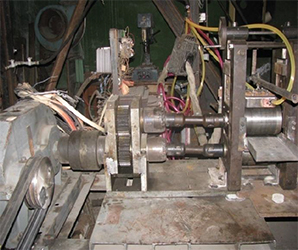
Eelectric rolling system “duo 150” – electric contact mechanism
On the basis of the experience gained at the Institute over the years and in collaboration with Rustavi Metallurgical Plant, it has been designed the foundry and rolling installation and made a test machine, which is mounted at the Institute. Based on intensive research, the design of themachine has been improved and it was masteredfor the production of aluminum sheets with thickness of 8–10mm. The mentionedinnovative method is a symbiosis of casting and rolling. Method in 6–7 times reduces energy-losses and decreases by 60–70% a number of costly devices and installations and, in general, andhas avery positive impact on the reducing the capital costs.
* * *
One of the most important areas of metallurgical direction of the Institute is the development of environmentally sound technology utilization & recycling of the industrial waste.
* * *
The Institute staff was actively involved in the studying process in the Georgian Technical University; they have written a number of textbooks for students-metallurgists:
1. A.D.Nozadze, A.I.Tutberidze. Theory of Metal Forming. Tbilisi, 1987.
2. A.I.Tutberidze. Theory of Rolling of Tubes. Tbilisi, 1989.
3. A.I.Tutberidze. Rolling of Non-Ferrous Metals and Their Alloys. Tbilisi, Technical University, 2003.
4. A.I.Nozadze, T.G.Namicheishvili, A. A.Kostava. Theory of Plasticity. Tbilisi, 1989.
5. I.B.Baratashvili, A.G.Gabisiani, B.M.Mirianashvili, G.B.Kashakashvili, I.Kashakashvili. Steel Metallurgy. Tbilisi, Metsniereba, 2003.
6. O.V.Shuradze. Variable Parameters of Systems in Equilibrium State. Tbilisi, Saunje, 2010.
7. O.V.Shuradze. Durometery. Tbilisi, Saunje, 2010.
8. O.V.Shuradze. Mechanical Properties of Metals and Methods for Their Determination. Tbilisi, Saunje, 2014.
LEXICOGRAPHICAL ACTIVITIES
By the employee of Institute O.V.Shuradze were compiled and published:
1. In 1993 - the Georgian–Russian–English–German–French Dictionary of Terminology Metals Science and Thermal Processing of Metals. In 1996 O.V.Shuradze was awarded the George Nikoladze Prize of the Georgian Academy of Sciences.
2. In 1999–2000, it was published the Georgian–Russian–English–German–French Dictionary of Metallurgical Dictionary. Main Terms.
3. In 2008, it was published Georgian–Russian–English Dictionary of Inorganic Materials Science and Metallurgical Terms, which was given the status of a normative vocabulary.
The Institute has restored its broken relationships with scientific research institutions of Ukraine, Russian Federation and Republics of Transcaucasia; also it has established new relationships with research centers in the USA, United Kingdom, Israel, and Turkey.
At the moment there are partner relations with the Acad. Yevgeny B. Paton Electric Welding Institute, Ivan Frantsevich Institute for Problems in Materials Sciences, Dnepropetrovsk`s Academy of Metallurgy, University of Technology (Technion) in Haifa, Israel, Berkeley Center of Chemical Engineering and Materials Science in the United States and the Center of Materials Research and Production Technologies at theIstanbul Technical University, Turkey.
